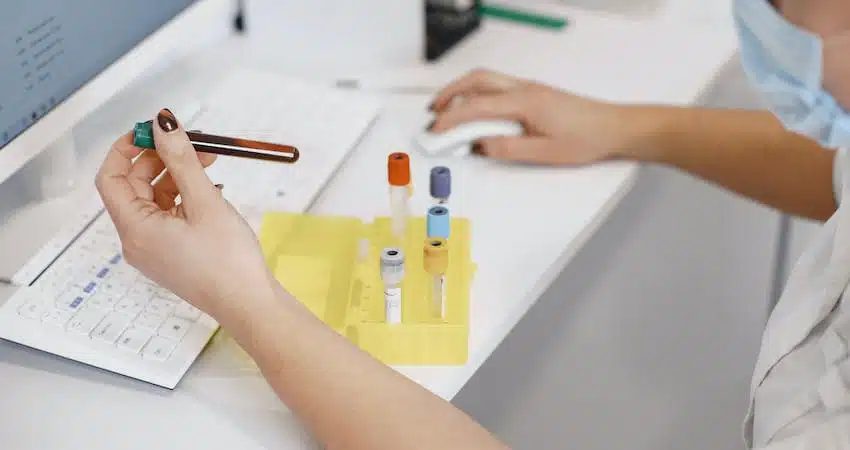The delicate balance of chemicals inside a woman’s vagina plays a crucial role in preventing infections, facilitating conception, and regulating hormones across life stages. But disturbing that balance can quickly wreak havoc on feminine health and comfort. Understanding the science behind vaginal pH empowers every woman to optimize wellness and promptly address issues if imbalances arise.
What is Vaginal pH?
Vaginal pH refers to the precise measurement of acidity or alkalinity within the vaginal canal and cervical fluids. It acts as a vital biomarker for evaluating conditions influencing the vagina’s microbial ecosystem and overall well being.
The standard pH scale runs from 0-14, with lower scores being increasingly acidic and higher values more alkaline. Vaginal pH naturally fluctuates from 3.5-4.5 in reproductive years, trending mildly upwards after menopause. But radical shifts above or below that norm often signal developing problems requiring attention.
Why Vaginal Acidity Matters
Beyond just preventing infection in the short run, maintaining optimal vaginal pH has wide-ranging impacts for women’s wellbeing.
- Fertility – Homeostatic vaginal pH creates the ideal environment for conceiving and carrying a pregnancy. Too high pH interferes with sperm motility and survival, reducing fertility. Low pH also protects sperm and embryos from harmful microbes trying to ascend the reproductive tract.
- Preventing Chronic Disease – When pH drifts too high or low, harmful bacteria can migrate out of the vagina to the uterus, Fallopian tubes, and beyond. This allows localized infections to become systemic, raising the risk of pelvic inflammatory disease (PID), infertility, chronic pelvic pain, and ectopic pregnancy.
- Promoting Intimate Wellness – Proper vaginal pH prevents dryness, irritation, odor, and discomfort during intercourse. This fosters positive intimate experiences and sexual wellbeing.
How Menstrual Cycles Impact Vaginal pH
Cyclical variations in vaginal acidity align closely with hormonal rhythms of menstruation. In the days following menstrual bleeding, pH measures in the more alkaline range around 6-7 sans progesterone’s modulating effects.
Approaching ovulation halfway through the cycle, rising estrogen levels work on glycogen-filled epithelial cells lining the vagina to increase lactic acid production. This lowers pH to the desired acidic norm of 3.8-4.5. Vaginal fluid volume also increases at this stage, enhancing acidity.
If pregnancy does not occur, falling estrogen/progesterone towards menstruation reverse these effects, returning pH to the alkaline side until the next cycle starts the oscillation anew. In essence, vaginal pH acts as a useful indicator of where a woman is within her hormonal arc each month
Menopause and Vaginal pH
Once women pass through menopause, the cessation of cyclical hormonal fluctuations stabilizes vaginal pH at the higher alkaline baseline around 6-7. Without estrogen’s impact, lactic acid output falls, thinning protective secretions.
This alkaline shift allows unfavorable bacteria associated with conditions like bacterial vaginosis to colonize and create imbalances linked to common menopausal vaginal symptoms such as dryness, irritation, discharge and odor. Managing menopausal vaginal pH issues often involves topical estrogen creams or tablets that locally restore pH balance.
Vaginal pH and Pregnancy
Tracking vaginal pH offers clues into what’s happening during the complex hormonal dance of pregnancy. Right after fertilization, pH trends alkaline around 7 as menstrual cycling’s influence lifts. But within a week, the rapidly multiplying embryo’s hormones modify pH back down to the fertile range around 4-5.
This lower pH both protects against vaginal infections compromising pregnancy and creates an acid medium boosting sperm survival benefitting conception. Around the 10 week mark as the placenta develops, pH rises to a moderately alkaline plateau around 6 persisting throughout pregnancy. After delivery, vaginal pH slowly returns to regular cycling patterns.
When Vaginal pH gets Disrupted
Multiple influences beyond menstruation and aging can disturb the vagina’s delicate pH balance. Identifying and modifying these factors restores acidity essential for keeping feminine health on track.
Common Causes of Altered Vaginal pH:
- Menopause – With menopause comes a permanent drop in estrogen. Chronically lower estrogen translates to higher pH and greater susceptibility to vaginal atrophy and urinary tract infections (UTIs).
- Medications – Certain prescription medications directly impact vaginal pH:
- Antibiotics: By killing all bacteria indiscriminately, antibiotics allow yeasts like Candida to proliferate, raising pH.
- Spermicides: Contraceptive foams, gels, and creams are alkaline, increasing pH and infection risk.
- Hormonal birth control: Methods like the pill and Depo shot can indirectly influence vaginal pH by altering natural hormonal cycles.
- Personal Care Products – Many over-the-counter feminine care items also disrupt delicate vaginal balance:
-
- Douches: Douching washes away good bacteria, allows pH to rise, and has been linked to pelvic inflammatory disease and ectopic pregnancy.
- Deodorant sprays: These contain chemicals that destroy lactobacilli essential for acidity.
- Scented soaps: Fragrance alters pH and provokes sensitivity reactions.
- Panty liners: Trapping moisture breeds trouble. Reserve use for heavy discharge days only.
- Medical conditions – diabetes, HIV, and others modify microbial balance
- Stress – releases hormones depleting lactobacilli and raising pH
Signs your Vaginal pH is too High
Sometimes a pH imbalance causes no outward symptoms. But there are several red flags to watch out for:
- Unusual vaginal discharge – Excessive, discolored, smelly
- Genital itching, burning, and irritation
- Pain or discomfort during sex
- Strong, fishy odor, especially after sex or menstruation
- More frequent UTIs
These could signal common pH-related conditions like bacterial vaginosis, yeast infections, trichomoniasis, or atrophic vaginitis.
When caught early, these infections can often be cleared up quickly with prescription antibiotic or antifungal medications. But left untreated, they may progress to more serious problems.
Monitoring any sudden changes and getting them checked promptly is key to maintaining gynecological health.
How to Test and Monitor Vaginal pH
Tracking your individual vaginal pH is the best way to catch fluctuations that might indicate emerging issues.
At-home vaginal pH test kits provide a quick and easy way to measure. These test strips or swabs change color upon contact with vaginal secretions. The color matches up with a scale that identifies the pH level.
Testing regularly lets you establish your baseline healthy pH. Watching for any major spikes out of your normal range signals when it’s time to see a doctor.
Once monthly is a good rule of thumb for most women. Increase frequency to weekly during special risk periods like menstruation, after taking antibiotics, or while pregnant or post-menopausal.
6 Ways to Maintain Healthy Vaginal pH
Small daily habits can go a long way toward promoting optimal acidity and preventing imbalance.
- Skip Douching – Douching destroys good lactobacilli, removes protective mucus, and leaves you prone to overgrowth of bad bacteria. Instead, wash only the external vaginal area with gentle, unscented soaps.
- Change Diet – Eat more yogurt and fermented foods like kefir, kimchi, and sauerkraut. Their good bacteria help produce lactic acid to lower pH. Cut back on refined carbs and sugar, which feed yeast. Stay hydrated to encourage mucus production.
- Wear Breathable Fabrics – Stick to cotton underwear and loose pants. Tight clothing traps heat and moisture, disturbing pH. Never wear thongs or pantyhose to the gym. Change out of wet workout wear ASAP.
- Avoid Irritants – Steer clear of douches, perfumes, glitter, fabric softeners, and colored/fragranced toilet paper that can provoke reactions. Use gentle, fragrance-free feminine wash only on the external vulva.
- Respect Your Vagina After Sex – Because semen is alkaline, wait 1-2 days between vaginal intercourse to give pH time to rebalance. Or opt for outercourse. Always urinate and avoid douching immediately after sex.
- Discuss Medications With Your Doctor – When prescribed antibiotics or hormonal birth control, ask about recommended probiotics or alternative options that won’t disrupt your natural flora.
When to See Your Healthcare Provider
Home remedies can often quickly resolve mild cases of vaginal pH imbalance and associated discomfort.
But if symptoms like discharge, pain, and itching persist or keep recurring, consult your gynecologist for specialized treatment.
Likewise, make an appointment right away if you experience any of the following:
- Foul-smelling vaginal discharge
- Burning or bleeding during/after sex
- Lower abdominal or pelvic pain
- Fever of over 100°F
These can indicate a more serious problem requiring swift medical intervention. Better safe than sorry when it comes to your vaginal health!
Describe all your symptoms in detail to receive proper diagnosis and a treatment plan. Your clinician can examine your vagina and take a swab to identify any out-of-balance microbes. They may also utilize pH strips internally to pinpoint current acidity levels and impact of any treatments implemented.
Based on all findings, your provider will offer customized recommendations to normalize pH and restore vaginal health if an imbalance has emerged. Don’t hesitate reaching out for personalized care optimizing your wellbeing.
The Takeaway on Vaginal pH
Vaginal pH might not be the most glamorous health topic. But monitoring and maintaining your vagina’s ideal acidic balance is one of the most fundamental ways you can prevent infection and safeguard lasting wellness.
Paying attention to what’s normal for your body, being aware of risk factors, and adopting pH-promoting habits allows you to stay in control.
Remember, only you live in your body 24/7. Trust yourself. Notice changes, listen to symptoms, and don’t be afraid to ask questions. When it comes to vaginal health, knowledge is power!



